Concrete products manufacturing and manufacturing. Production of reinforced concrete products: industrial methods and technologies
Reinforced concrete production is a complex, time-consuming and energy-intensive process.
In the manufacture of reinforced concrete products, skilled manual labor is used, and therefore the skills of all personnel involved in the production process play a large role.
Company "PK ZHBI MARK" one of the leading manufacturers of concrete products in Moscow. We produce the whole range of reinforced concrete products - plates, trays, pipes, rings, wells and other products. Our factory of concrete products manufactures products according to the approved technical documentation and technical conditions.
Reinforced concrete factories such as our company pay particular attention to quality and process compliance. Our production of reinforced concrete products fully complies with the standards and it follows all the rules and processes that ensure the highest quality of all products.
We produce concrete products of standard type sizes, but we can provide our customers with a unique service - production of concrete products according to your drawings.
Below is the order of the technological process on the example of some reinforced concrete products.
1. Form preparation - cleaning of concrete residues, checking the condition of the sides, liners, embedded parts, etc. All internal parts of the molds are carefully lubricated with special grease.
 |
||
 |
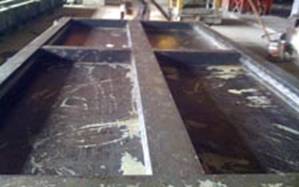 |
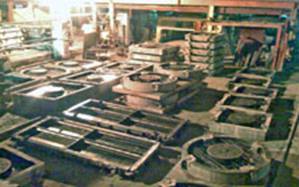 |
2. Product reinforcement - according to regulatory documentation.
The manufacture of metal structures includes the use of various machines, equipment and devices. The final assembly (knitting) of frames is carried out manually, which is due to their complexity and, accordingly, excludes manufacturing defects in the load-bearing structure of the product.
 |
 |
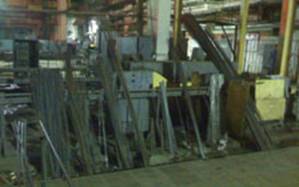 |
 |
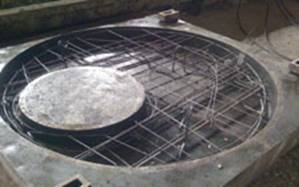 |
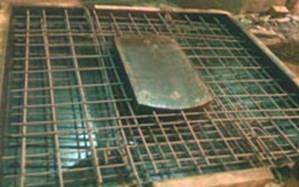 |
3. The formation of concrete products.
The mold is poured with a certain amount of concrete, brand according to the documentation. After this, the concrete should be compacted. For this, vibration platforms and tables of various types are provided, depth and mounted vibrators, vibration rails, etc. are also used. depending on the complexity of the metalloform. Concrete is compacted and uniformly formed. The front part of the products is smoothed in accordance with the requirements of TU. In some cases, the surface is additionally ground.
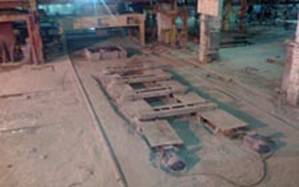 |
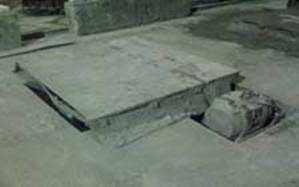 |
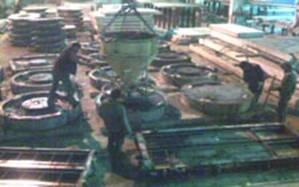 |
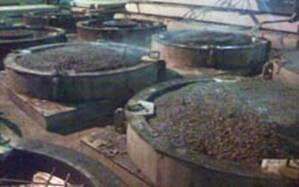 |
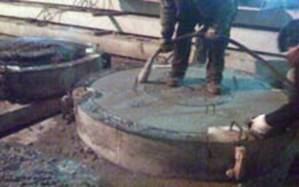 |
4. Drying of products. (Steaming).
The filled, vibrated forms are stacked in steaming chambers and are closed by covers. Under pressure, steam is supplied to the chambers. The steaming cycle is due to TU. As a rule, 4-10 hours. Depending on the temperature, steam pressure and volume of the product.
 |
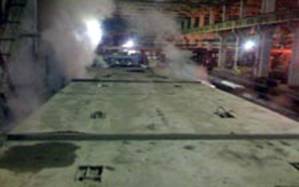 |
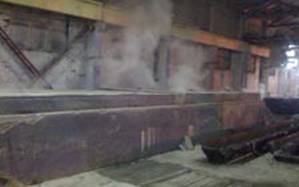 |
 |
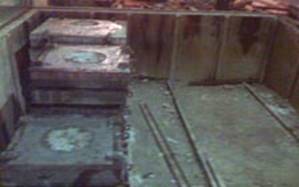 |
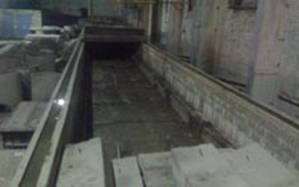 |
5. Formwork products.
The technical control department controls the entire cycle of the production process. At the final stage, after stripping the product, the strength of concrete is checked, the conformity of dimensions and technical specifications. Data is recorded in the product passport, the product is marked and sent to the finished goods warehouse.
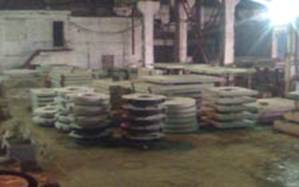 |
 |
|
 |
 |
The strength of concrete during storage under normal conditions according to GOST 10180 - 78 will reach the required strength of the corresponding design brand at the age of concrete 28 days from the date of manufacture of the products.
In this article we will consider what is the technology for the production of reinforced concrete products on an industrial scale, and in addition, we will determine what methods of casting concrete products are used in individual construction. But, before considering the technological features, we will talk about the main properties of reinforced concrete.
Features of the production material
Reinforced concrete is a material made using cement-containing mortars and metal reinforcing structures.
The manufacturing technology of reinforced concrete products is not new, since the fundamental methods were patented in the second half of the 19th century. However, mass application reinforced concrete structures and designs in the construction industry in the early twentieth century.
The use of this material in construction is not accidental, since reinforced concrete products are distinguished by the following qualities:
- resistance to the negative effects of a number of environmental factors;
- operational reliability and durability;
- reasonable price, in comparison with designs made using other materials;
- resistance to critical temperatures (both low and high);
- resistance to chemical and biological factors;
- high resistance to dynamic and static loads.
However, reinforced concrete products have some disadvantages. For example, the compressive strength of a material is less than that of a pure metal. With regard to large structures and structures, reinforced concrete products "bear" their mass an order of magnitude more than the payload.
Varieties of reinforced concrete
In the photo - shipment of finished floor slabs
Today, a wide range of various reinforced concrete products is manufactured and manufactured everywhere. And this is not surprising, since concrete products are used not only in construction, but also in other areas.
For example, most of the lighting poles and poles of power lines are traditionally made using reinforced concrete. From the same production material the most advanced and technologically advanced railway sleepers are made.
However, we will dwell on those modifications that have found application in construction.
Among them, we note the following varieties:
- foundation blocks wall (FBS);
- floor slabs;
- road plates;
- reinforced concrete piles;
- concrete supports and fences;
- decorative products used in the decoration of construction sites.
In the photo - finished products, including wall blocks and concrete rings
Let's talk about these varieties in more detail:
- Base blocks wall (FBS) - This is a modification of reinforced concrete products, which has found application as the main building material in the construction of prefabricated foundations and basements of various buildings. Such structures significantly reduce the time required for construction work, since the block is large and allows you to abandon the long and laborious bricklaying.
- Floor slabs - It is installed between floors. For the preparation of such products, especially durable brands of reinforced concrete are used, designed for large mechanical loads throughout the entire operational life.
To reduce the weight, the plates are hollow, which makes them lighter and less heat-conducting. Again, due to the cavities in the slabs, concrete is saved, which favorably affects the cost of the finished product.
- Road plates - it is concrete goods used at construction roadbed, runways of airfields and other surfaces, the strength of which is subject to increased requirements.
- - These are products that are used in construction, along with foundation blocks. Due to the increased resistance of concrete to the negative effects of environmental factors, such piles can be installed on various types of soil without compromising the quality of finished construction projects.
- Fences, supports and decorative products - This is a special kind of concrete goods, which performs not so much utilitarian as aesthetic function. Due to high consumer demand, the production of these concrete products is currently mastered by various small and small enterprises.
Features of manufacturing concrete products
The instruction for the manufacture of reinforced concrete products is determined by the basic properties of production materials. Cement-containing solutions are liquid or semi-liquid, and therefore the main technological feature of the production process is their pouring into special forms.
In fact, production technology involves the installation of a reinforcing frame in the mold cavity with your own hands and subsequent pouring of the solution. As the solution dries, the finished product gains the required strength. At the end of this process, the finished product is removed from the mold and can be used for its intended purpose.
The manufacturing technology of reinforced concrete and precast concrete products includes a list of individual operations that make up the production process. All operations carried out during the manufacture of reinforced concrete products are conventionally divided into main, auxiliary and transport.
Conditionally technological process can be divided into the following successively implemented steps:
- concrete preparation;
- rebar manufacturing and frame manufacturing;
- reinforced concrete products;
- molding concrete mix;
- temperature and humidity treatment of the product;
- decorative finish of the front surface.
Important: In the manufacture of exterior wall panels concrete structures may be subject to further refinement. Insulating materials can be laid in the panel, both during molding and during the assembly phase of individual shells of products.
Production equipment
In the photo - formwork for the manufacture of floor slabs
The equipment used in the production of reinforced concrete products, in accordance with the purpose, is divided into technological - basic, as well as auxiliary and transport. Equipment for the production of reinforced concrete products, involved in a single production complex, is called a technological line.
In the production of reinforced concrete products, special forms are used that can be made of metal, reinforced concrete, lumber of wood origin. Combined forms constructed using several different materials are also used.
In the photo - the use of vibropress during concrete compaction
Regardless of the type of materials used, finished forms must meet the following requirements:
- accuracy of ensuring the established standard sizes and configuration of products at the end of all technological operations;
- rational design and, as a result, a small mass of the form in relation to the mass of the finished product;
- lack of complexity and ease of assembly and disassembly;
- structural rigidity when pouring concrete with various indicators of density and specific gravity.
Important: The effectiveness of the application of production forms is largely determined by the correctness of the choice of lubricants. Properly selected lubricant prevents sticking of the mortar to the inner surface of the formwork, thereby contributing to the durability of the form and improve the quality of the manufactured concrete products.
- Production in non-moving type molds involves all technological operations, from preparation to dismantling the formwork in one place. An example of the implementation of such a scheme is the formation of concrete products in matrices, in cassettes or on flat stands.
- The production in displaceable type forms involves the phased transportation of formwork with a filled solution from one production station to another. Such a production scheme extends to the inline aggregate and conveyor molding method.
- Continuous molding is a relatively new production scheme that is characterized by efficiency, high productivity and relatively low energy consumption. The method is carried out using a vibratory rolling mill.
Concrete reinforcement
Regardless of what equipment is used for the production of reinforced concrete products, the most important technological step is the reinforcement of the mixture. And this is not surprising, since the method of implementing the reinforcement of mortars determines such parameters of the finished structure as the strength and cost of concrete products.
Important: According to statistics, the price of a finished reinforced concrete product by 20-30% depends on the cost of reinforcement. Therefore, the approach to developing the features of reinforcing reinforced concrete structures is important both technically and economically.
In the photo - frames for casting piles
Reinforcement of mortars in the production of reinforced concrete is of two types: prestressed and ordinary - unstressed.
Let us consider in more detail the features of the implementation of each of these methods, since the strength properties of the finished products depend on them by and large.
- Unstressed reinforcement of reinforced concrete products is carried out both using a spatial frame and by means of flat nets made of wire rod or steel rods with the corresponding cross-sectional diameter.
Frames, during such reinforcement, can only be manufactured using the welded method. Unstressed reinforcement is divided into main (working) and auxiliary (mounting).
The main reinforcement is placed in areas undergoing maximum tensile stresses. Ancillary reinforcement, on the contrary, is used in those areas of reinforced concrete products where tensile stress is absent or, on the contrary, compression is present.
- Stress reinforcement of reinforced concrete involves the creation of preliminary compression, both in the area of \u200b\u200btensile stresses and throughout the cross section of reinforced concrete. For example, in the manufacture of foundation blocks or piles, the preliminary reduction parameters are up to 60 kg / cm². Compression is carried out by tensioning the reinforcement for a certain time.
Conclusion
So, we examined the main points of the production process, and, in addition, we listed the operational features of precast concrete products. You can take into account the information received both when ordering ready-made concrete products, or when using reinforced concrete in individual construction.
Have any questions? Comprehensive answers can be obtained by watching the video in this article.




